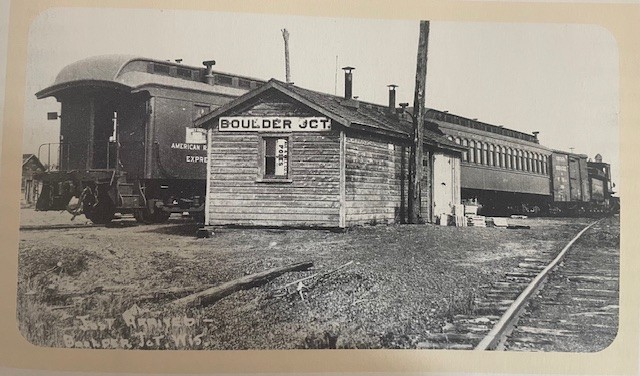Boulder Junction Railroad Depot
Introduction
Text-to-speech Audio
A community’s successful growth is often based on transportation to a desired location. And even though the railroad ran through and around the Northwoods of Wisconsin for the lumber industry since the 1880’s, the addition of a railroad depot made Boulder Junction a welcoming destination for those coming to live and work and fish and relax.
In 1909, three10 foot sections of building arrived and these prebuilt structures became the Boulder Junction Train Depot.
The depot was located near the current Northern Highland Sport Shop. The depot welcomed folks to our growing community for about 20 years. When the railroad was decommissioned, primitive roads became access. The depot was bought by Sam Williams, relocated to Boulder Lake and was used as a cottage. Eventually the Boulder Junction Area Historical Society acquired the structure. It was moved and restored and now can be seen along side of the Boulder Junction Area Historic Museum. You can visit the depot at 5358 Park Street Plus tour the museum to learn about more wonderful Boulder Junction treasures.
Images
Depot Depot circa 1915 with hotel

DepoBoulder Junction: '

Depot Converted to Cabin
.jpg)
Depot Home at the Museum
.jpg)
Depot Restoration Discovery of Graffiti

Backstory and Context
Text-to-speech Audio
The small depot arrived in Boulder Junction in 1909. At that time it was listed on railroad inventory along with other inventory. It was located near where Northern Highland Sports Shop is located today.
In 1903 the Milwaukee Road extended its line from Star Lake, running track along the North side of White Sand Lake. Continuing to Cutler Junction, continuing north to Boulder Junction, as a logging railroad.
The BJ Depot served as a Depot from 1909 until 1931. When the railroad went out the Depot was purchased by Sam and Ada Williams, moving it to Boulder Lake to be used as a cottage. At the same time they purchased the water tower. The wooden water tower was taken to the Boudreau sawmill on Hwy H & K and cut into lumber. They used the lumber to build porches on their cottages. Two porches were placed on the old Depot.
In 1956 John Anderson bought the resort and put in electricity and plumbing. It became a two bedroom, one bath cottage. The cottage was known as “Heather Cottage” on Boulder Lake.
In 1980 Dorothy Boudreau, a board member of the BJAHS, discovered the Depot and with agreement of the board, decided to restore the Depot.
Jeff Long, BJ chairman, offered three sites to move the Depot to. With discussion and voting it was decided to move the Depot to its site next to the BJ Community Center on Park Street.
Discovered during the restoration was 80+ year old “graffiti”. One name, Tom Moore was very elegantly carved into the outside wall of the depot, with many initials carved on the walls as passengers waited for the train.
The BJAHS is proud to have the Depot displayed next to the BJ museum along with the original Boulder Junction railroad sign.
The depot/museum at 5364 Park St, Boulder Junction, WI 54512 is open 10:00am-2pm Tuesdays June through August and Saturdays 10:00am-2pm June-September or by special request; Josie 715-385-2617
Sources
Laabs, Joyce. "'Metamorphosis :From 'shack' to historical landmark." Lakeland Times . .
Doolittle, Shirley. Boulder Junction: the early years 1880-1950. Friends of the Library, c1996.
Burnes, Richard. Ticket to Buswell. 5/2/2024.
Boudreau, Dorothy. Boulder Junction: 'The Way We Were'. Boulder Junction Area Historical Society. 2005.
Manitowish Waters Historical Society
Boulder Junction: 'The Way We Were'
Boulder Junction: 'The Way We Were'
Boulder Junction: 'The Way We Were'
Boulder Junction: 'The Way We Were'
